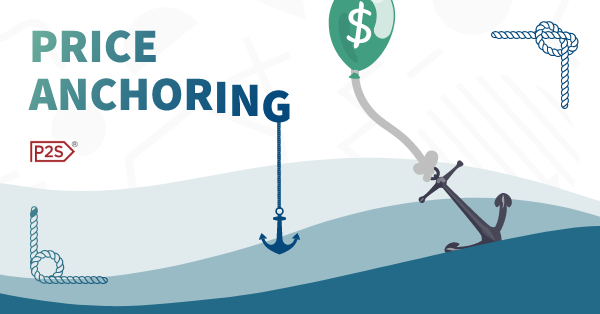Price anchoring: Is anchor price bringing more sales?
How would you like to choose the price of products that you’re buying? Well, there are some businesses that are offering just that! Such businesses are based on a “pay what you can” system where customers can choose among a few prices.
You might be surprised to know that this actually brings profit to the company.

But, the secret lies in their pricing strategy: anchor price. This strategy enables you to guide the customers to buy the item at the exact price you want them to pay.
Sounds like a mind trick, right? If we got you interested, let’s dive deeper into the secrets of this pricing strategy.
What is price anchoring?
Price anchoring stands for a pricing strategy where the business is establishing the price to which customers can refer when purchasing. In practice, whenever you see a discount, the higher price serves as an anchor price for the sales price.
For example, the eCommerce apparel brand Everlane used this system a few years ago to sell discounted items. They were offering 3 different prices, where the lowest one covers only the producing and shipping costs. The middle one stands for production, shipping, and overhead for Everlane’s team, and the highest one includes production, shipping, and overhead, and a little extra for Everlane to reinvest.
How is this working?
You might think that all this sounds nice, but how is it possible that it works? A well-known saying in the pricing world goes “How can you sell a $3000 watch? Present it next to a $10000 watch.”
The truth is that there is no cheap or expensive product because customers perceive prices relatively. The essential idea behind this concept is comparison. Apple lovers will for sure remember the presentation of the iPad. After giving the introduction, Steve Jobs said that Apple should sell this product for $999 with giant numbers appearing behind him. However, the turning point was him saying that they decided to sell it for $499! As you can imagine, everyone who even considered buying an iPad was overly enthusiastic. Of course, Apple’s revenue was no less enthusiastic either.
Customers tend to decide whether a product is cheap or expensive based on the comparison with the price they knew about first. That’s why some prices seem like a scored bargain while others leave a feeling of losing out. Guided by this, companies often show both prices – the previous one crossed out and serving as an anchor price and the new, lower price.

It’s important to note that price anchoring can work in two ways:
- High price anchor
Do you remember that we mentioned that with price anchoring you can increase the sales of the desired product, and even at a price that suits you? Well, that’s done by using a high price anchor tactic.
Companies that sell electronic devices usually turn to this trick, so for sure you saw one of those commercials where a 50-inch TV is advertised for $1000, and next to it a 48-inch TV for the price of $700. When seeing this, people who are on the hunt for a good deal will most likely go for the second option. The second TV is only 2-inches smaller, but they will save $300 which is a great catch.
And that’s how companies have scored by using the high price anchor technique. The cheaper TV was the product they wanted to sell in the first place – they just managed to present it as a more appealing offer by putting it next to a more expensive option.
2. Low price anchor
The low price anchor tactic achieves the same result but works a bit differently. The aim is to sell the more expensive product by presenting it in a way that seems like a more reasonable option to go for.
For instance, if there is an offer of having a 500MB/day package for $15.99 and having an unlimited data package for $29.99, what would you choose? That’s right – you would go for the second option as probably would everyone else. Nowadays users don’t find 500MB nearly enough, hence, the unlimited package that’s only a tad more expensive really is a catch. We’re sure that you’ve got the idea by now – the goal all the way along was to sell the more expensive product, by making it look like a more reasonable option.
When price anchoring doesn’t work?
As with all the other pricing strategies, there is a possibility that price anchoring is just not suitable for all businesses.
Using this pricing strategy wouldn’t be pretty wise in case the customers are already familiar with the product and its value. They know what to expect and the best that you can get away with is a slightly elevated price. In such cases, the higher price will be connected to a higher quality, but the room for the increase is not so big as it usually would be with anchor pricing.
Another scenario where it would be smart to avoid this pricing technique is when dealing with savvy customers. Such customers make a detailed investigation before purchasing, therefore, they know how much the product is actually worth. In other words, they’re resilient to anchor prices.
Price anchoring examples
Strike-through pricing is probably one of the most used and easiest to recognize examples of price anchoring. It’s consisted of two prices, where the old one is crossed out, but it serves as an anchor price for the new price that’s written just beside it.
The second also well-known structure is comparative package pricing. Behind this strategy lies a psychological pricing methodology called bracketing. Companies conduct this strategy usually by offering 3 pricing options – on the budget one, standard, and a premium one. This approach relies on the logic that people tend to avoid extremes. The lowest pricing option will be perceived as something too limited, while the premium one as something overly complicated, and therefore pricey. By doing so, you’re making the standard option the best one. Therefore, the two extreme options serve as anchors.
Another possibility is to use your competitors as anchors. While promoting their price plans, some companies tend to compare them with their closest competitors to show what would be the smartest choice.
Source: BusinessWire
How to implement a price anchor strategy
One of the easiest ways of doing this is by creating a tiered pricing strategy. In other words, providing different prices for different product versions. Most of the companies go for this option, therefore, you’ll see a few pricing plans displayed on their website.
Others decide for showing competitor prices, but we need to ask you to cautious there. Customers are looking for a true value, not just for lower prices. If you only compare the prices without explaining what makes YOU stand out, customers will understand it as a cheap trick.
We would recommend you to play on the safe side, while at the same time being cautious of competitor pricing actions. And how do you achieve that? By letting one of the price monitoring tools help you. These kinds of solutions can help you track your competitors’ price changes and moreover, help you adjust your pricing strategy so that’s in alignment with current market conditions.
Conclusion
Pricing strategies can seem overwhelming, not just for beginners, but for business professionals as well. Finding the right strategy is not an easy task and therefore do not be discouraged by not-so-successful beginnings. Price anchoring might look easy, but as you can see, there is a lot of research going on “behind the scenes”. This is exactly what distinguishes successful from unsuccessful businesses.
As always, we encourage you to learn as much as you can about pricing strategies before making a decision. Thus, we hope that anchor prices seem more understandable now.
In case you are already using price anchoring, please feel free to share your experience with our readers, they’ll appreciate it! 
Looking forward to reading your comments!



